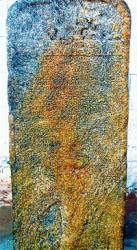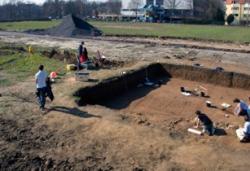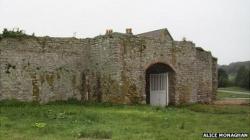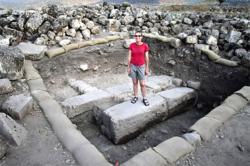INSTITUT SUPERIEUR D'ANTHROPOLOGIE
INSTITUTE OF ANTHROPOLOGY
ONLINE COURSES / COURS A DISTANCE
INSCRIPTION 2012 / Session III : Juillet 2012
REGISTRATION 2012 / Term III : July 2012
INDE –  Saligrama - According to a press release from Prof T Murugesh, Department of Ancient History and Archaeology, MSRS College, Shirva, said the inscription is found engraved on a rectangular stone slab, in old Kannada characters. About 29 lines are engraved on the slab. On the top, a damaged Shivlinga sculpture is found. The epigraph is begun with an invocation to Lord Shiva, in the first and second line. In the fifth line, the ruling monarch is described as ‘Rajaadhiraja Raja Parameshwara’. The Malappa Odiya referred in the epigraph has been found in the many other inscriptions of Tulunadu. He was referred as the governor of Tulu, hayive, and Konkana and ruling from his capital Barakuru. He was ruling Tuluva region from 1386 AD to 1390 AD. During this period, the emperor of the Vijayanagar dynasty was Harihara II.
Saligrama - According to a press release from Prof T Murugesh, Department of Ancient History and Archaeology, MSRS College, Shirva, said the inscription is found engraved on a rectangular stone slab, in old Kannada characters. About 29 lines are engraved on the slab. On the top, a damaged Shivlinga sculpture is found. The epigraph is begun with an invocation to Lord Shiva, in the first and second line. In the fifth line, the ruling monarch is described as ‘Rajaadhiraja Raja Parameshwara’. The Malappa Odiya referred in the epigraph has been found in the many other inscriptions of Tulunadu. He was referred as the governor of Tulu, hayive, and Konkana and ruling from his capital Barakuru. He was ruling Tuluva region from 1386 AD to 1390 AD. During this period, the emperor of the Vijayanagar dynasty was Harihara II.
http://www.deccanherald.com/content/267698/vijayanagar-inscriptions-found-udupi.html
FRANCE – Nice - Les fouilles estivales sur la colline du Château se révèlent fructueuses: les archéologues ont dégagé un mur qui pourrait remonter au IIe siècle avant Jésus-Christ! Est-ce l'un des vestiges de l'antique cité de Nikaïa la ville fondée par des colons grecs de Massalia? Pour répondre à la question, il faudra sans doute attendre les campagnes de fouilles futures, lesquelles permettront une datation définitive. Une énigme historique est peut-être en passe d'être résolue avec le positionnement géographique exact de ce qui fut la Nice des origines. Les archéologues ont également dégagé les vestiges du château du 13e siècle sur le sommet de la colline, en contrebas de la terrasse panoramique prise d'assaut l'été par les touristes.
http://www.nicematin.com/nice/fouilles-archeologiques-sur-la-colline-du-chateau-a-nice-decouverte-dun-mur-qui-pourrait-etre-c.945690.html
ARMENIE –  ’Aghavnadan - Découverte archéologique majeure en Arménie. Lors des fouilles sur le site d’Aghavnadan dans la région d’Armavir, une équipe d’archéologues arméniens a découvert un objet représentant une sorte de statue réalisé à l’âge de pierre datant de 250 000 à 300 000 ans. Affirmation de Boris Kasparian le responsable de la mission archéologique, membre d’Institut de recherches nationales de l’Académie des Sciences d’Arménie. « Cependant cet objet ne subit pas pour l’heure d’une quelconque datation scientifique pour le dater avec précision » a confié l’archéologue qui affirme également que cette année les découvertes sur le site d’Aghvanadan sont très nombreuses. Selon Boris Kasparian, fin août, une équipe d’archéologues arméno-allemands effectuera des recherches dans la région de Sissian. Il est attendu que ces fouilles puissent aboutir à découvrir des éléments sur l’installation des premiers homo-sapiens sur le territoire actuel de l’Arménie.« Ces découvertes répondront à de nombreuses questions » dit Boris Kasparian.
’Aghavnadan - Découverte archéologique majeure en Arménie. Lors des fouilles sur le site d’Aghavnadan dans la région d’Armavir, une équipe d’archéologues arméniens a découvert un objet représentant une sorte de statue réalisé à l’âge de pierre datant de 250 000 à 300 000 ans. Affirmation de Boris Kasparian le responsable de la mission archéologique, membre d’Institut de recherches nationales de l’Académie des Sciences d’Arménie. « Cependant cet objet ne subit pas pour l’heure d’une quelconque datation scientifique pour le dater avec précision » a confié l’archéologue qui affirme également que cette année les découvertes sur le site d’Aghvanadan sont très nombreuses. Selon Boris Kasparian, fin août, une équipe d’archéologues arméno-allemands effectuera des recherches dans la région de Sissian. Il est attendu que ces fouilles puissent aboutir à découvrir des éléments sur l’installation des premiers homo-sapiens sur le territoire actuel de l’Arménie.« Ces découvertes répondront à de nombreuses questions » dit Boris Kasparian.
http://www.armenews.com/article.php3?id_article=81316
ROYAUME UNI –  Alderney - A team from the island, the UK and Guernsey are excavating land at the fort of the nunnery at Longy Common. The dig is focusing on a gateway and wall but the team said they were "not expecting" the way it was laid out. Dr Jason Monaghan said: "We've found something interesting, but we don't actually know what it is until we take a bit more dirt out." Dr Monaghan, Director of Guernsey Museums, said the team had dug a trench to examine the gateway. "It's a bit perplexing, the nunnery always throws little surprises at us and the wall has changed below the ground level and we weren't expecting that to happen so we need to know why it's changed," he said. On a previous dig the site was found to be a well-preserved Roman military structure dating back to the 4th Century after a building and tower were uncovered. Following that dig, Dr Monaghan said: "It's better preserved than all the other small Roman forts in Britain. "It probably guarded the entrance to Longis Bay, Alderney's only natural harbour, and I think they would probably have based a couple of Roman warships there."
Alderney - A team from the island, the UK and Guernsey are excavating land at the fort of the nunnery at Longy Common. The dig is focusing on a gateway and wall but the team said they were "not expecting" the way it was laid out. Dr Jason Monaghan said: "We've found something interesting, but we don't actually know what it is until we take a bit more dirt out." Dr Monaghan, Director of Guernsey Museums, said the team had dug a trench to examine the gateway. "It's a bit perplexing, the nunnery always throws little surprises at us and the wall has changed below the ground level and we weren't expecting that to happen so we need to know why it's changed," he said. On a previous dig the site was found to be a well-preserved Roman military structure dating back to the 4th Century after a building and tower were uncovered. Following that dig, Dr Monaghan said: "It's better preserved than all the other small Roman forts in Britain. "It probably guarded the entrance to Longis Bay, Alderney's only natural harbour, and I think they would probably have based a couple of Roman warships there."
http://www.bbc.co.uk/news/world-europe-guernsey-19027764
ISRAEL –  Houcoq - Les vestiges d’une monumentale synagogue remontant aux IVe et Ve siècle, sous l’Empire byzantin, ont été découverts en Israël lors de fouilles en Galilée. Selon le communiqué, les archéologues ont notamment récemment mis au jour dans le village de Houqoq une mosaïque richement décorée représentant l’histoire biblique des 300 renards utilisés par Samson pour incendier les champs des Philistins. Un peu d’histoire biblique. Samson, par vengeance, avait alors attaché à des tisons enflammés aux queues des renards, accolés deux par deux. Il n’y avait pas de SPA à l’époque. Le chiffre 300 constituait en revanche alors un chiffre symbolique. «Il n’existe que deux autres synagogues de cette époque montrant des scènes figurant Samson», a déclaré l’archéologue, citée dans le communiqué. Celle-ci a par ailleurs souligné «la taille monumentale» des pierres utilisées pour l’édifice.
Houcoq - Les vestiges d’une monumentale synagogue remontant aux IVe et Ve siècle, sous l’Empire byzantin, ont été découverts en Israël lors de fouilles en Galilée. Selon le communiqué, les archéologues ont notamment récemment mis au jour dans le village de Houqoq une mosaïque richement décorée représentant l’histoire biblique des 300 renards utilisés par Samson pour incendier les champs des Philistins. Un peu d’histoire biblique. Samson, par vengeance, avait alors attaché à des tisons enflammés aux queues des renards, accolés deux par deux. Il n’y avait pas de SPA à l’époque. Le chiffre 300 constituait en revanche alors un chiffre symbolique. «Il n’existe que deux autres synagogues de cette époque montrant des scènes figurant Samson», a déclaré l’archéologue, citée dans le communiqué. Celle-ci a par ailleurs souligné «la taille monumentale» des pierres utilisées pour l’édifice.
http://www.tdg.ch/culture/Decouverte-d-une-monumentale-synagogue-byzantine-en-Israel/story/13646616
USA – Philadelphia - A two-week archaeological probe of what was the city's 17th- and 18th-century riverfront uncovered great rounded timbers laid side by side, most likely evidence of the James West shipyard, built before the arrival of William Penn. Mancl was standing over a seven-foot-deep, 25-foot-long trench cut through an old Hertz parking lot on Columbus Boulevard near Vine Street. When Penn arrived in 1682, the West shipyard had already been bustling for six years. It remained a functioning waterfront operation until the early 19th century. The Milner crew cut three trenches on the Hertz lot. One, at the north end toward Callowhill Street, yielded water and little else. The trench furthest to the east exposed what Mancl called "massive stones" that reminded him of "pier construction."Most of the focus of the dig was on the trench farthest to the west, in which timbers were exposed. Because of the color and the lay of the soil, Mancl said, the timbers were probably "cribbing," possibly laid to drain marshy soil at river's edge. In addition to the large underground beams and stones, the Milner crew unearthed some ceramic artifacts that probably date to the 18th century or earlier. In addition to the large underground beams and stones, the Milner crew unearthed some ceramic artifacts that probably date to the 18th century or earlier.
http://articles.philly.com/2012-07-28/news/32907408_1_timbers-trench-hertz